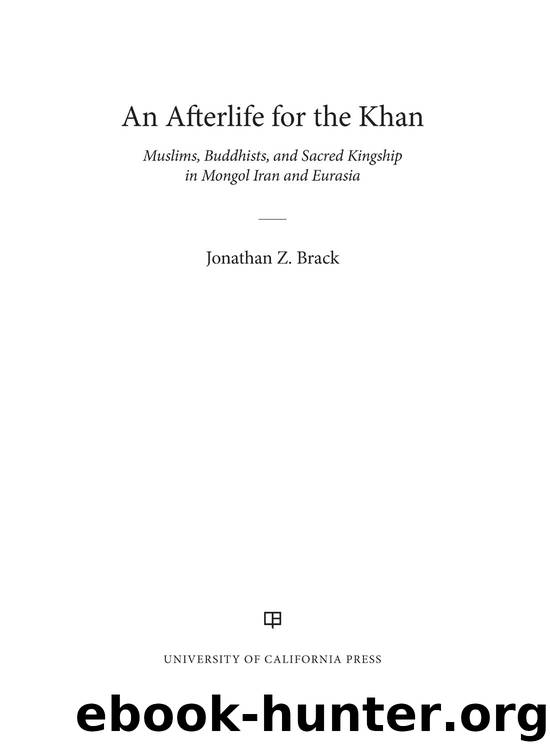An Afterlife for the Khan by Dr. Jonathan Z. Brack;

Author:Dr. Jonathan Z. Brack;
Language: eng
Format: epub
ISBN: 9780520392908
Publisher: University of California Press
CHANGING BURIAL PRACTICES: FROM DIVINIZED ABSENCE TO MONUMENTAL SHRINES
The Chinggisid successors legitimized their rule by maintaining a ritualized connection with Chinggis Khan. Correct reverence for the imperial founder conferred the right to imperial domination.2 As part of the Mongolsâ immanentist-divinized model of kingship, this ritualized commemoration guaranteed the continuous flow of Heavenâs blessing to the Chinggisid line. From the theoretical perspective, the dynastic veneration of the imperial founder reflected the Chinggisidsâ transition from the heroic mode of kingship to the âmore passive cosmic mode in which the king was not himself a being stretching for divinity but an interlocutor with Heaven, a stationary ritual pivot.â3 In the cosmic mode, this veneration also served to unite the community, as it connected the âritual expressions of communal sanctityâ with the participation in rites that evoked the universal sanctity of the Chinggisid line.4
Chinggis Khanâs successors, especially Chinaâs Yuan and post-Yuan Mongol rulers, cultivated their ritualized connection with the imperial founder by expanding the devotional cult. During the 1260s, Qubilai established an eight-chambered complex where the remains of Chinggis Khan and his offspring were housed, and rituals were performed four times annually, probably in a seasonal routine.5 The Mongols were keen on appropriating not only the technological, intellectual, and material resources of their subjects but also their spiritual and ritual assets. In turn, their subjects offered their own and even othersâ ritual resources to advance their own agendas and gain royal patronage. Confucian and Buddhist rituals and traditions were appropriated to buttress the Chinggisid cult and the dynastyâs funerary tablets and portraits were placed in Confucian ancestor temples in the capital, in the Hanlin academy, and in ancestral halls in Beijingâs main Tibetan Buddhist monastic centers.6
The Ilkhans also practiced the Chinggisid ancestor cult. Ãljeitüâs itinerary, for example, included repeated visits to his brotherâs tomb in Sham-i Ghazan, west of Tabriz, where âmemorial feastsâ of milk, alcohol, and sacrificial meat were possibly offered to Ghazanâs remains or to his effigy.7 Yet, Mongol burial customs also changed considerably in the Ilkhanate with the transition from unmarked gravesites to monumental tomb structures. The practice of burying the Chinggisid khans in undisclosed and forbidden gravesites, known as qoruq, stood in contrast to Muslim practices of burying the royal dead under monumental domed structures.8 Peter Jackson suggests that this difference, alongside other cultural-religious distinctions, might have initially hindered the Mongolsâ conversion to Islam.9
After Ghazanâs conversion, however, the Ilkhans transitioned almost immediately to the construction of monumental tomb structures. The practice of burying the Mongol elite in monumental structures seems to have been likewise adopted by Mongols who were not converts, further suggesting that the gap between the two practices might not have been so great.10 Both burial practices, in fact, ultimately had the similar function of sanctifying the rulerâs grave, though they also carried different implications: the overstated absence of the qoruq, through its inaccessibility, secrecy, or âunknowability,â bolstered the supernatural, divinized power of the buried remains of the Chinggisid king; whereas the monumental, visually rich presence of the
Download
This site does not store any files on its server. We only index and link to content provided by other sites. Please contact the content providers to delete copyright contents if any and email us, we'll remove relevant links or contents immediately.
| Central Asia | Southeast Asia |
| China | Hong Kong |
| India | Japan |
| Korea | Pakistan |
| Philippines | Russia |
The Sympathizer by Viet Thanh Nguyen(4065)
The Rape of Nanking by Iris Chang(4001)
World without end by Ken Follett(3330)
Ants Among Elephants by Sujatha Gidla(3268)
Blood and Sand by Alex Von Tunzelmann(3035)
Japanese Design by Patricia J. Graham(2982)
City of Djinns: a year in Delhi by William Dalrymple(2417)
Foreign Devils on the Silk Road: The Search for the Lost Treasures of Central Asia by Peter Hopkirk(2375)
Inglorious Empire by Shashi Tharoor(2326)
In Order to Live: A North Korean Girl's Journey to Freedom by Yeonmi Park(2288)
Tokyo by Rob Goss(2278)
India's Ancient Past by R.S. Sharma(2269)
The Queen of Nothing by Holly Black(2265)
India's biggest cover-up by Dhar Anuj(2228)
Tokyo Geek's Guide: Manga, Anime, Gaming, Cosplay, Toys, Idols & More - The Ultimate Guide to Japan's Otaku Culture by Simone Gianni(2221)
The Great Game: On Secret Service in High Asia by Peter Hopkirk(2218)
Goodbye Madame Butterfly(2151)
Batik by Rudolf Smend(1995)
Living Silence in Burma by Christina Fink(1964)
